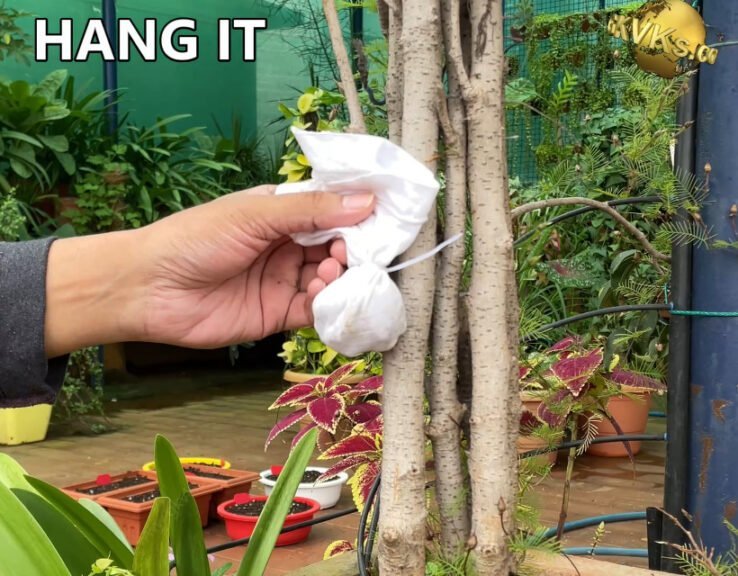Contents
In today’s post, we’ll explore five incredible uses of asafoetida in your garden. From serving as a natural fertilizer to acting as a powerful pesticide, asafoetida can help treat various plant diseases, repel pests and rodents, and much more.

Introduction
First and foremost, it’s important to remember this key principle—avoid using chemical pesticides and fertilizers. These substances can have hazardous effects on both humans and animals. That’s why we promote the use of natural agents or organic alternatives on this gardening website. One such powerful natural agent is Asafoetida.
What is Asafoetida?
Asafoetida, commonly referred to as “Hing,” is a unique and aromatic flavoring agent that is a staple in many kitchens, particularly in Indian cuisine. It is derived from the dried latex or gum that is exuded from the rhizome or tap root of the Ferula Asafoetida plant, which is native to regions of Iran and Afghanistan.
Known for its pungent odor, asafoetida is often used in small quantities to enhance the flavor of various dishes, lending a savory, umami taste reminiscent of garlic and leeks. Beyond its culinary uses, asafoetida is also valued in traditional medicine for its potential digestive benefits and is a popular ingredient in vegetarian and vegan cooking, as it adds depth to dishes without the use of animal products.
Scientific Basis of its Use in Gardening and Farming
Before we get into its applications, let’s take a closer look at its composition. Typical asafoetida contains:
- 40–64% resin
- 25% endogenous gum
- 10–17% volatile oil
- 1.5–10% ash
The resin and volatile oil portions contain strong compounds responsible for its pungent odor and beneficial properties.
Besides its medicinal properties, asafoetida has several amazing uses in gardening and farming:
- Natural pesticide: Effectively controls a wide range of pests and insects, including destructive termites, which can cause significant damage to wooden structures and furniture, making it essential for homeowners to address these issues promptly.
- Rodent repellent: Effectively deters rodents and other animals from invading your garden, protecting your plants and ensuring they thrive without the threat of unwanted pests. This solution creates a barrier that keeps your garden safe and flourishing.
- Disease treatment: Treats plant diseases such as leaf curl virus, which can significantly impact crop yield and quality when left unaddressed, and currently have no effective treatment options available. This solution provides a much-needed defense for affected plants, helping to restore their health and productivity.
Let’s explore how to use Asafoetida for each of these problems.
How to Use Asafoetida to Treat Leaf Curl Disease
Leaf curl disease is common in pepper and tomato plants. Here’s a step-by-step guide to using asafoetida to treat it:
- Prepare the Solution: Start by taking one liter of sour buttermilk, which is rich in beneficial bacteria, or 500 ml if you have fewer plants to treat. In a mixing bowl, add one teaspoon (about 5 grams) of asafoetida powder, a natural remedy known for its pest-repelling properties. Mix the two ingredients thoroughly until the asafoetida is fully dissolved in the buttermilk, ensuring an even consistency.
- Set Aside: Once mixed, set the solution aside and allow it to sit at room temperature for 1 to 2 hours. This resting period helps to activate the beneficial enzymes in the sour buttermilk, enhancing its effectiveness as a pest deterrent.
- Filter: After the mixture has rested, it’s important to filter it to prevent any lumps from clogging your spray bottle. Use a fine cloth or a strainer to sieve the solution, ensuring that only the smooth liquid is collected for application.
- Spray: With your filtered solution ready, take a spray bottle and fill it up. Apply the mixture thoroughly over the affected plant, making sure to cover all areas, including the underside of the leaves where pests often hide. It’s best to spray during the early morning or late afternoon to avoid direct sunlight, which could cause the solution to evaporate quickly.
- Repeat: For optimal results, repeat the spraying process every 3 days for a total of 3 to 4 times. This consistent application will help to effectively manage any pest issues and promote healthier plant growth. Remember to monitor your plants for any signs of improvement or further infestation.

How to Use Asafoetida to Repel Insects and Termites
To effectively repel insects and termites, follow these steps:
- Create a Sac: Begin by taking 50 grams of asafoetida, preferably in its raw cake form, as this type tends to be more potent and effective. Asafoetida, known for its strong aroma and medicinal properties, will serve as a natural deterrent.
- Wrap in Cloth: Next, take a clean piece of cotton cloth and carefully place the asafoetida in the center. Gather the corners of the cloth and tie them securely to form a small sac. Ensure that the sac is well-sealed to prevent the asafoetida from spilling out while allowing its fragrance to escape.
- Hang: Finally, find a suitable location to hang the sac. Suspend it over the tree or plant you wish to protect, ideally in a spot where it can catch the breeze. This will help disperse the strong scent of the asafoetida, creating a natural barrier against pests and promoting healthier growth for your plants.

How to Use Asafoetida to Repel Unwanted Animals and Rodents
If rodents and other animals are creating havoc in your garden, use asafoetida as follows:
- Use a Larger Quantity: Begin by wrapping approximately 100 grams of asafoetida in a clean cotton cloth. This aromatic resin is known for its strong smell, which can effectively deter pests. Ensure that the cloth is securely tied to prevent the asafoetida from spilling out.
- Place Strategically: After preparing the sachets, strategically position them around your garden. Aim to cover an area of about 1 to 2 square meters. Placing them near the edges of flower beds or vegetable patches can create a protective barrier, helping to keep unwanted insects and pests at bay while allowing beneficial organisms to thrive.
How to Use Asafoetida as an Organic Fertilizer
Using asafoetida as a liquid fertilizer boosts the plant’s immune system and protects it from various diseases:
- Prepare the Solution: Begin by measuring out 2 grams of raw asafoetida or its pure powder form. Carefully add this to 1 liter of clean, filtered water to ensure the best results. This potent ingredient is known for its beneficial properties for plant growth.
- Mix Well: Stir the mixture continuously for several minutes to ensure that the asafoetida fully dissolves and is evenly distributed throughout the water. This step is crucial as it maximizes the effectiveness of the solution when applied to your plants.
- Water Plants: Use this specially prepared solution to water your plants occasionally, particularly during their early growth stages when they are most vulnerable. This nutrient-rich mixture can help promote healthy root development and overall plant vigor.
- Foliar Spray: Alternatively, you can use the solution for foliar spraying, which involves lightly misting the leaves of your plants. This method allows for quick absorption of nutrients and can be especially beneficial during warm weather or dry conditions, ensuring that your plants receive the care they need.
How to Use Asafoetida as an Organic Pesticide
For an effective organic pesticide:
- Prepare the Solution: Begin by taking 1 liter of clean water, preferably distilled or filtered, to ensure the best results. Gradually add 5 grams of asafoetida powder or, if you have it, asafoetida in cake form, ensuring it dissolves well in the water for an even distribution of its properties.
- Add Neem Oil: Next, carefully mix in about 5 ml of neem oil, known for its natural pest-repelling qualities. It’s essential to stir the mixture thoroughly to ensure that the oil is well-blended with the water and asafoetida, maximizing its effectiveness.
- Spray: Once your mixture is ready, use a spray bottle to apply it generously to the affected plants. For best results, make sure to cover both the upper and lower surfaces of leaves and repeat this process once weekly. This will help maintain healthy plants and deter pests effectively.
Conclusion
By integrating asafoetida into your gardening routine, you can reduce the need for harmful chemicals while promoting a healthier environment. Whether you’re treating plant diseases, repelling pests, or boosting plant health, asafoetida is a versatile and powerful tool.
Please Watch a detailed video on Asafoetida uses below:
